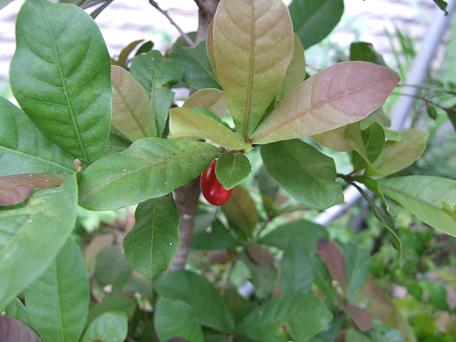Justicia betonica is traditionally used in western Kenya as a treatment for minor snakebites. One chews the leaves and spits the saliva maceration on the site of the bite.
Synsepalum dulcificum - miracle fruit
The Miracle Fruit is native to West Africa where it is cultivated in backyard plantings. Today it has been introduced to Florida, California and numerous tropical areas of the world, however you will find most people have never heard of it. The fruit is more of a novelty then a significant source of food or nutrients, however there appears to be increasing interest in the berry and the incredible sweetening effects it has when eaten in conjunction with sour and acidic foods.
The taste of the fruit itself is nothing spectacular to speak of. There is relatively little fruit around the shiny seed. The pulp tastes somewhat like a cherry. However, due to a substance in the fruit called ‘miriculine’ it has the power to inhibit the receptors of sour and acidic flavors on your tongue, thus rendering certain foods sweet when normally they are sour, such as lemons, tomatoes, beer, some cheeses, hot sauce, vinegar, wine, and so forth. Miracle fruit changes the flavor of foods and beverages that you wouldn’t typically consider to be sour or acidic, and some foods are not affected at all.
There is growing interest in this fruit looking into its potential applications in cancer and diabetes research.
The tree is small, with attractive foliage, and, when in fruit, covered in bright red berries. I have a huge number of these trees in urban nurseries, they are great for container growing and seem to produce more fruit when its roots are somewhat contained.
Article from the New York Times: A Tiny Fruit That Tricks the Tongue
Cola nitida - Cola nitida, Cola nut, Abata cola, gbanja cola, goro cola, labozhi kola
ORIGIN AND DISTRIBUTION
C. acuminata is indigenous to Congo, Nigeria, and Gabon, while C. nitida (photographed above) occurs naturally in Ashanti, the Ivory Coast, and Sierra Leone.
USES, ETHNOBOTANY AND NUTRITION
Cola nitida flower.
The seeds, or nuts, of Cola have been chewed since ancient times in West Africa for their stimulant properties. Cola nuts make up a very important product in regional West African markets. Historically, cola nut was also used to flavor cola soft drinks but are now largely supplanted by synthetic products. The embryo, seed, or “nut”, varies considerably in size and weight. A nut will typically contain 2 – 3 percent caffeine, to which the nuts stimulating effects are ascribed. Theobromine is also present in the nut in significant quantities.
Cola nitida seeds / fruit.
As far as nutritional value, the cola nut is unimportant, as only small amounts are consumed. The nuts do, however, have some health benefits when used in moderation. Seed extracts are used to treat mental and physical fatigue, and are considered useful as a tonic (mild diuretic, secretion of gastric juices is stimulated). People suffering from ulcers or hypertension should restrict their intake of caffeine.
PROPAGATION AND CULTIVATION
Cola nitida germinates quickly from seed. The fresher the seed the better. As with many tropical species, seeds to not retain viability for very long.
Seedling leaves of Cola nitida.
When cultivated, the tree is typically managed below 10 m high, with long lateral branches, like cacao. Cola acuminata is considered secondary in masticatory quality to C. nitida.
I took the photos in this post at Summit Botanic Garden outside Panama City.
Two lesser known species are bamenda cola (C. anomala), and owé cola (C. verticilla)




